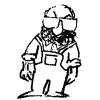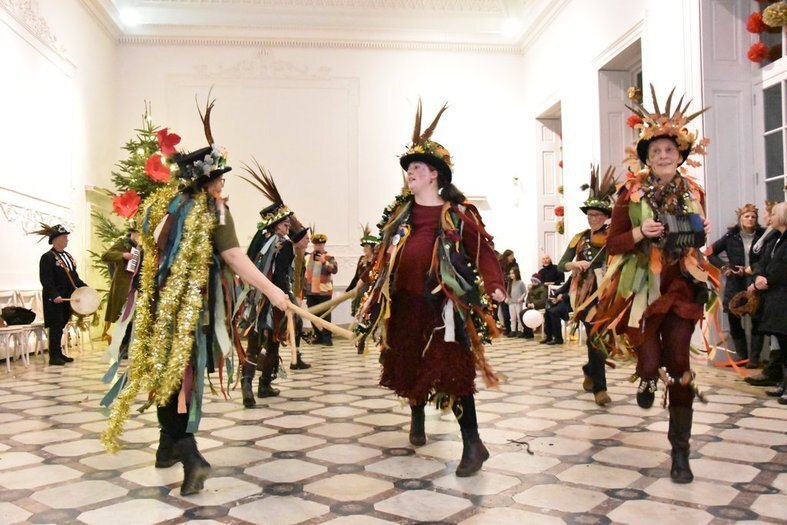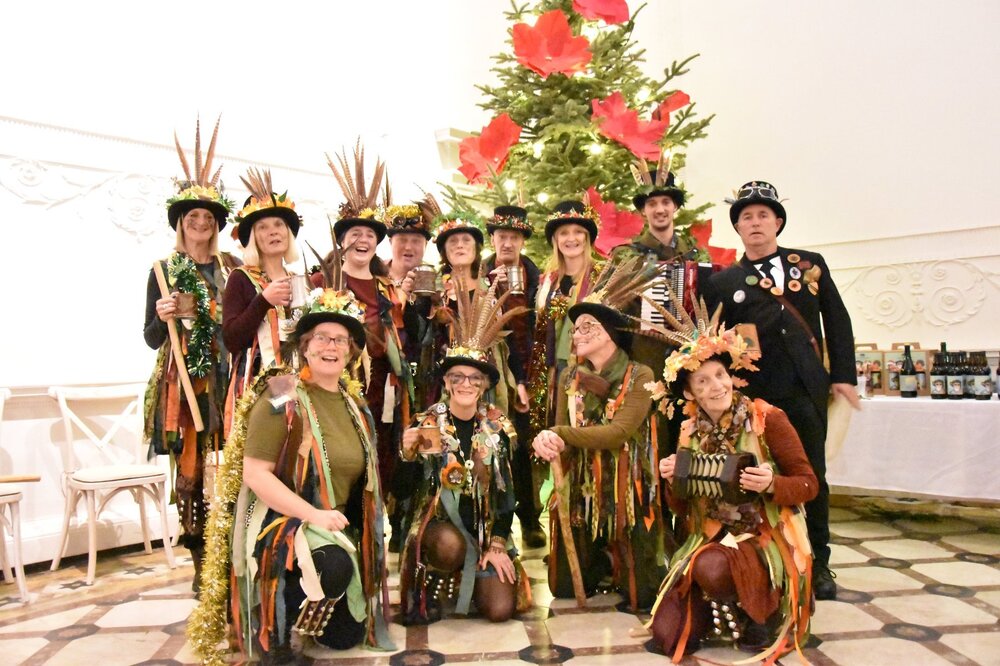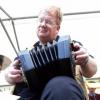Search the Community
Showing results for tags 'Dance'.
-
I have been reading (and listening) with great pleasure to Dan Worrall's book House Dance. I highly recommend it, both as a wonderful window into concertina history and an education in how to play the Anglo like the real old timers. I am a newbie on the concertina; I don't think I'd even qualify as a toddler, yet. But as someone who has played harmonica for years, and who acquired a melodeon shortly before acquiring an anglo concertina, I began my concertina playing without much in the way of instruction. Since I already understood the structure of the scale and how the buttons worked, I just dove in, transferring some of my harmonica repertoire over to the squeezebox. Rather quickly, and instinctively, I started playing some tunes in octaves -- at first along the row, and then discovering that I could move down to the G row in order to gain notes above A on the left hand. The same trick work on the right hand, too! Eventually, messing around on the web, I found that this octave style was indeed one of the ways folks traditionally approached the instrument, and I discovered Worrall's House Dance, which focuses on just that style of play. Octave playing was once the most common approach to the anglo (or German concertina), used to gain volume and reinforce the beat when a single unamplified concertina might be the only source of music for thirty couples dancing across the dirt floor of a settler's home in South Africa -- or across a wooden platform laid down at some Irish crossroads. I mentioned "listening" to House Dance. The "book" is delivered on CD as a set of well-illustrated web pages and associated audio files. So, as you read about the differences in the octave playing of Scan Tester and William Kimber, you can actually listen to recordings that illustrate the point. The first six chapters of House Dance provide a historical exploration of the concertina's place providing music for dance in the late 1800s and early 1900s in England, Ireland, Australia, and South Africa. The second six chapters look in depth at the playing of traditional concertina artists from each of these countries -- and provide a tutorial in the octave style. The huge number of recordings that accompany the text are a wonderful resource. And these are not recordings that you're going to find on Spotify. (I know; I've looked!) They are from private collections, museums, and other hard to find sources. In addition to music, there are also recordings of interviews with old-time players, talking about the octave style and the house dance context in which it was used. The whole thing is just a flat out marvelous piece of work -- and not just for the historian. There's plenty to learn about playing the anglo in the "pages" of House Dance. I've gone on enough. I ordered my copy of the CD from the Button Box. But there are other places to get it. Worrall's website will point you to the options. All the profits from sale of the book go to the English Folk Dance and Song Society. It's just an excellent piece of work. Dan deserves plenty of thanks for creating it. Happy Squeezing! Greg
- 5 replies
-
- Octave style
- dance
-
(and 2 more)
Tagged with:
-
This is a short review of the book 'There was None of this Lazy Dancing' by Bob Ellis. The book is about the music played at dances in the Yorkshire Dales. There are a lot of good (folk) tune books. There is a smaller but significant number of books dealing with the social history of (folk) music. There are very few books which deal with both the music and the social history of the music. This book is a significant addition to that small sub-genre. The book is a collection of tunes played at dances in the Yorkshire Dales. The tunes are presented in a way which describes and discusses their use by placing them in the context of the social events at which the tunes were played, and by using short biographies of some of the musicians who played the music. The tunes themselves are a mix of the familiar and the not-so-familiar. Where necessary, tunes in 'unfriendly' keys are also supplied in transpositions to a 'friendly' key, usually G, so the tunes should be easily accessible to G/D and C/G concertina players? (Note however, that the book is not concertina-specific, and as far as I am aware, is not intended to be Dance instructions are also included, as are comprehensive cross-referenced indexes of both the tunes and the dances. This is an absolutely splendid mix of academic rigour, relevance and readability. The book is also well-illustrated and well made (hard cover, stitched signatures, lay-flat binding). The fortunate purchaser of the book will also receive a password giving access to ABC transcriptions of all the tunes. The author asks, (very reasonably), that this password not be passed on to those who have not purchased the book. The ABC code appears to be of original transcriptions by the author. The style of coding is consistent, concise (minimalist, if you prefer), unambiguous and correct. As with the printed text, where the original of the tune was in an 'unfriendly' key, the author has provided a transcription into a 'friendly' key. In brief, this is a superb book! The only irritating thing about the book is that there is a picture of the author on page 5. I'm sure I know the man from somewhere, and can't for the life of me remember where or when I encountered him. Bloody infuriating!
- 5 replies
-
- book review
- yorkshire
-
(and 4 more)
Tagged with:
-
Playing and dancing! Does anyone have any experience? I never set out to do it consciously, but whilst we were playing for a dance, recently, I ended up dancing at the same time. It's only a single step, but it's a start! It felt very natural indeed. I've seen some musicians dancing Cotswold jigs whilst playing a fiddle or melodeon and that looks pretty full-on! I'd love get a feel for Cotswold stepping and how that "feels" to play and move to, but there are no sides closer than 50 minutes away that I could dance with. We are definitely in the middle of deep deep Border country Holly is behind me, here, on fiddle. We were moving around, engaging with the audience and generally having a fun time. The concertina is well suited to dancing, I think, because it's relatively small and light. I need to think a bit more about what works and doesn't, musically, when dancing (and when playing standing up), but it's encouraging. This is at Compton Verney, the impressive 18th century building/art gallery a good hour or so east, in Warwickshire - Bow Brook Border Morris were dancing there as part of an early Wassail evening. Unusual for us to dance inside for a Wassail! (Some musicians were escorting the public around the trees outside too) It was quite a full-on performance, as we were the only side dancing and in between dances the musicians and those of us dancers who were also musicians, took a turn to play tunes. I did get to sing a couple of mid-wintery songs too. Revving up for Wassail season coming soon!
- 16 replies
-
- 2
-

-
The tune for this week is the "Sett Quadrille". It#s a very energetic dance with three steps in a bar. Two things show how powerful this dance is: The tempo is difficult to find out in the living room. The joke says play it so fast that the dancer's face turns red. Then slow down a bit. The other thing is a picture in my head when our female dance leader stands beside the group and is clapping so that they get more motivated. They need every help.. It is hard work for the musician, too, but I have a drink beside me. Seth Quadrille.mp3 Shared with Dropbox DROPBOX.COM
-
The subtleties of French dance rhythms can be tricky. Chris Ryall made a collection of video field recordings of different dance types at Embraud last year. I've begun posting these: http://accordeonaire.blogspot.com/2014/04/french-dance-field-recordings-part-1.html Thanks Gary
-
The 6th of April is the date for our annual Old Fashioned Night Out - a day of music, singing and dancing the way we do things down our way. Read all about it here: http://www.singdanceandplay.net/940/ As you'll see, the band is made up of trad music class members augmented by a few pals to make sure the evening goes with a swing - which, judging by previous events, it will in spades. Free-reed equipped pals playing with the band will include Steve Harrison and Will Duke, as well as myself. I'm writing to say that if anyone would like to come along that night and join the band for a few tunes - or all - they are welcome to join us, so long as they let me know in advance. The tunes are already on the Traditional Music Class page... Gav






